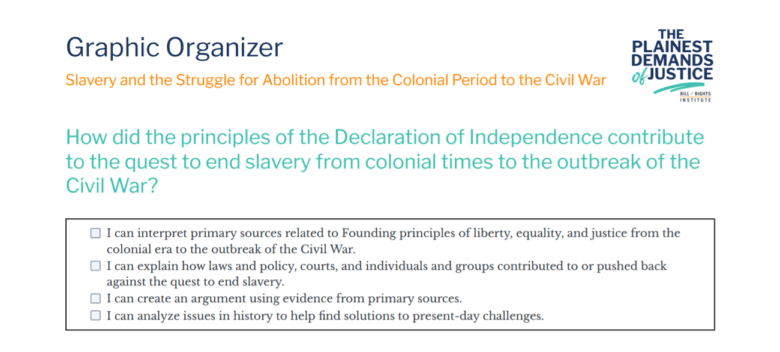Graphic Organizer: The Struggle for Abolition
How did the principles of the Declaration of Independence contribute to the quest to end slavery from colonial times to the outbreak of the Civil War?
- I can interpret primary sources related to Founding principles of liberty, equality, and justice from the colonial era to the outbreak of the Civil War.
- I can explain how laws and policy, courts, and individuals and groups contributed to or pushed back against the quest to end slavery.
- I can create an argument using evidence from primary sources.
- I can analyze issues in history to help find solutions to present-day challenges.
Directions: Identify the main ideas and connections to the Founding principles using the information you gathered from your assigned documents.
| Document Title and Date | Main ideas | Connection to or Violation of Founding Principles |
|---|---|---|
| *Enactment of Hereditary Slavery Law, Virginia, 1662 | ||
| Germantown Friends Protest Against Slavery, 1688 | ||
| An Act for the Better Ordering and Governing Negroes and Other Slaves, South Carolina, 1740 | ||
| John Woolman, “Some Considerations on the Keeping of Negroes,” 1754 | ||
| Thomas Paine, “African Slavery in America,” 1775 | ||
| Belinda Sutton, Petition to the Commonwealth of Massachusetts, 1783 | ||
| Correspondence between Benjamin Banneker and Thomas Jefferson, August, 1791 | ||
| Ohio State Constitution, 1803 and Black Code, 1804 | ||
| U.S. Congress: An Act to Prohibit the Importation of Slaves, 1807 | ||
| James Forten, from “Letter I: Letters from a Man of Color, on a Late Bill before the Senate of Pennsylvania,” 1813 | ||
| U.S. Congress: An Act to Authorize the People of the Missouri Territory to Form a Constitution and State Government (Missouri Compromise), 1820 | ||
| David Walker, Appeal, in Four Articles, 1829 | ||
| The Underground Railroad and Networks to Freedom | ||
| Maria Stewart Advocates Education for African American Women, 1832 | ||
| William Lloyd Garrison, American Anti-Slavery Society Declaration of Sentiments, 1833 | ||
| John C. Calhoun, Speech on Abolition Petitions, 1837 | ||
| U.S. Supreme Court, U.S. v. Amistad 40 US 518, 1841 | ||
| Frederick Douglass, Narrative of the Life of Frederick Douglass, an American Slave, 1845 | ||
| Sojourner Truth, “Ain’t I a Woman?” 1851 | ||
| Solomon Northup, Twelve Years a Slave, 1853 | ||
| George Fitzhugh, Sociology for the South, or, The Failure of Free Society, 1854 | ||
| U.S. Congress, An Act to Organize the Territories of Nebraska and Kansas (Kansas-Nebraska Act), 1854 | ||
| Abraham Lincoln, Speech on the Repeal of the Missouri Compromise, 1854 | ||
| U.S. Supreme Court, Dred Scott v. Sandford 60 US 393, 1856 | ||
| John Brown’s Last Speech, 1859 | ||
| Harriet Jacobs, Incidents in the Life of a Slave Girl, 1860 | ||
| Chart: Slave population in 1860 |
